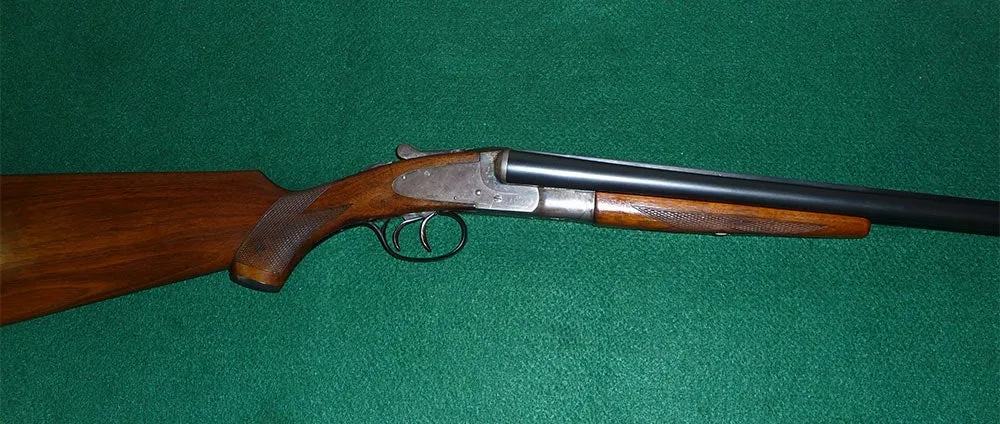_We may earn revenue from the products available on this page and participate in affiliate programs. Learn more ›
_
Some Blast from the Past guns arrive so perfectly and completely written that all I have to do is post them. That’s the case today with this gun, a bare-bones L.C. Smith field grade. According to the 1913 Smith catalog: “This gun is especially designed for those requiring a cheap, sound, and plainly finished weapon. It is particularly useful for field and marsh where rough usage is required.”
Field-grade L.C.’s, true sidelocks just like the higher grades, were made beginning in 1912 and they lasted until 1945, when they were bought by Marlin. Marlin made the guns until 1950, when they became casualties of World War II mass-production techniques. There’s nothing fancy about these guns, and there are plenty around if you want to own one yourself. Nearly 200,000 were made. This one, however, is not for sale…again.
Gmoaksie’s LC Smith
Your recent post about Bob’s long-lost Stevens Model 94 inspired me to contribute to Blast from the Past. This is my old L.C. Smith field-grade 16 gauge that I first owned when I was in college back in the early ’80s. I bought the battered old gun from a farmer for $250, because I wanted a double gun badly and it was the only thing I could afford as a struggling student._
The barrels were silver and scraped and pitted in spots; the case colors were mostly gone, leaving the action in what could generously be described as patina. The original stock finish was cracked and flaking, and the wood itself was dented, scraped, and dinged—including a long gouge behind the left-side lock plate (not a crack, as are so often present on L.C. Smiths, but a deep scrape). The grip cap had a chip knocked out of it. But, the stock had never been cut and the gun was “all there.” I cleaned up the bores and, to my surprise, they shined like glass. The action was still tight with the lever slightly right of center. Back then, we were allowed to keep our shotguns in the closets of our dorm rooms. Imagine that. A buddy of mine took it home with him one weekend and patterned it for me and proclaimed it a shooter.
And so I shot it. A lot. In those years, I hunted ducks every weekend in October with a fraternity brother on a pothole lake near his great uncle’s farm. It was a shallow, spring-fed lake of a hundred acres or so surrounded by corn fields. No public access—we had to drive through a neighboring farmer’s feed lot to reach the shore to launch a boat. Back then it was a duck magnet in the fall and we’d hammer them every weekend—and quite a few week day mornings, too. Little wonder it took me five years to get my degree. The old gun shot 5s and 6s very well with its 28-inch Full and Modified barrels, and I loved it in spite of its cosmetic flaws.
One year, during Christmas break, I refinished the stock in the basement of my folks’ house. I stripped the old finish with Zip-Strip and 0000 steel wool. I rubbed several coats of Tru-Oil on it, knocked the shine down a bit with burlap, and the wood looked a lot better, although it made the metal look even worse by comparison. By the time I graduated from college, steel shot was the law of the land and the gun was relegated to the closet. I hunted doves with it a time or two in the ’90s, and I took it out a few times in those years to shoot some sporting clays, but that was about it. About 10 years after that, hard-up for gun money, I sold it to a family friend.
Fast-forward a few more years, and the fellow to whom I sold the gun was ready to pare back his collection and offered to sell the gun back to me if I wanted it. I did, and he was gracious enough to let me have it for what he’d paid me for it years earlier. I took it down to a local gunsmith. When I picked the gun back up, I was pleased with the results. The barrels have been rust-blued. The trigger bow and fore-end release inlay have been hot-blued. The stock was refinished and a replacement grip cap fitted. The smith was able to raise the gouge behind the lock plate some; it’s still there but less noticeable. He was reluctant to remove the locks so the receiver has not been re-case colored, but for less than the cost of a round of golf with cart, beer, lunch, and a cigar, I have a good-looking shooter that I can still shoot and feel good about doing it. Now, it goes on the occasional preserve shoot for pheasants and chukars.
I learned my lesson about parting with guns that have meaning. My wife will have to wait until I’m gone to get the money back out of this one. Whenever I pick it up, I wonder what that old farmer would think of his L.C. now. Sadly, the fraternity brother I hunted with during college passed away a few years ago. I really wish he was still around to see it, too.
Thanks Gary. Nice job refinishing the gun, too. A lot of times when people tell me they have “restored” a gun I wince. Not here.


